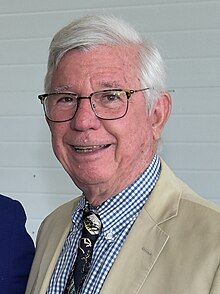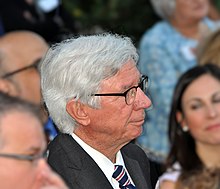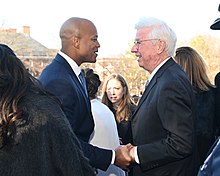| Parris Glendening | |
|---|---|
 | |
| 59th Governor of Maryland | |
| In office January 18, 1995 – January 15, 2003 | |
| Lieutenant | Kathleen Kennedy Townsend |
| Preceded by | William Donald Schaefer |
| Succeeded by | Bob Ehrlich |
| Chair of the National Governors Association | |
| In office July 11, 2000 – August 7, 2001 | |
| Preceded by | Mike Leavitt |
| Succeeded by | John Engler |
| 4th Executive of Prince George's County | |
| In office 1983–1994 | |
| Preceded by | Lawrence Hogan |
| Succeeded by | Wayne K. Curry |
| Personal details | |
| Born | Parris Nelson Glendening (1942-06-11) June 11, 1942 (age 82) New York City, U.S. |
| Political party | Democratic |
| Spouse(s) | Lynne Shaw (divorced 1970s) Frances Hughes (m. 1976; div. 2001) Jennifer Crawford (m. 2002) |
| Education | Broward College Florida State University (BA, MA, PhD) |
| Signature | |
Parris Nelson Glendening (born June 11, 1942) is an American politician and academic who served as the 59th governor of Maryland from 1995 to 2003. He previously served as the county executive of Prince George's County, Maryland from 1982 to 1994 as a member of the Democratic Party. In 1999, Glendening was elected as a fellow of the National Academy of Public Administration.
Early life, education, and academic career
Glendening was born in The Bronx, New York City, but later in his youth moved to the state of Florida. Raised Catholic, he attended St. Thomas Aquinas High School in Fort Lauderdale. He won a financial scholarship to Broward Community College.
Other financial aid later enabled him to attend the Florida State University, where he received a bachelor's degree (1964), a master's degree (1965), and a PhD (1967), becoming the youngest student in FSU history to receive a doctorate in political science.
When he graduated, he taught government and politics as a professor at the University of Maryland at College Park for 27 years. In 1977, he co-authored Pragmatic Federalism: An Intergovernmental View of American Government with Mavis Mann Reeves.
Local politics
Glendening's career in public service began in 1973 as a city councilman in the Washington, D.C. suburb of Hyattsville, Maryland. He was elected to the county council of Prince George's County, Maryland, in 1974 and twice served as the council chairman. In 1982, he was elected as the county executive of Prince George's county, eventually becoming the first county executive in Maryland history to be elected to three terms (1982–94). Under Glendening's leadership, Prince George's county was selected as an "All America County" by the National Civic League, and City and State Magazine named him the "most valuable county official" in the nation. He and his top aides stood to benefit from a controversial Prince George's county supplemental retirement plan that was not widely disclosed by the press until after he was elected governor in an extremely close contest.
Governor of Maryland
Elections
Glendening was elected to his first term as governor of Maryland, edging out Ellen Sauerbrey, the Republican nominee, by 5,993 votes. Sauerbrey challenged the result in Maryland circuit court claiming that widespread voting by dead people occurred in the African American community. No evidence of ballots cast in the names of dead voters was introduced in court. On the eve of the trial, Sauerbrey's attorneys talked of 89 such votes, but checking by reporters found no such ballots. Judge Raymond G. Thieme Jr. ruled against Sauerbrey's claim and certified Glendening's win. Glendening became the first Maryland governor elected from the Washington, D.C., metropolitan region since Oden Bowie was elected in 1867. In 1998, Glendening won re-election to a second term, again defeating Sauerbrey, this time 55%–45%.
Tenure

Glendening's early administration was marked by higher education investment, environmental protection, tax reform and economic development. From 1994 to 1998, he cut or lowered more than 50 Maryland taxes, including the state personal income tax. By the end of his first term, Maryland's national rank in job creation had moved from 43rd to 14th. Glendening's job creation efforts focused mainly on biotechnology. Seeking to make Maryland a world leader in this area, Glendening successfully recruited companies such as Human Genome Sciences, Gallow Lab, and Qiagen to Maryland. As of June 2014, Maryland was home to the second-largest biotech cluster per capita in the U.S.
Glendening also assisted in successfully bringing the National Football League teams Washington Redskins from Robert F. Kennedy Stadium in the neighboring District of Columbia (Washington, D.C.) who now play in a new stadium in Landover, with then owner Jack Kent Cooke, and the relocated franchise Baltimore Ravens, from Cleveland, Ohio, as the former Cleveland Browns with owner Art Modell to play in Baltimore after two years in a new stadium as part of the sports complex at Camden Yards, west of the redeveloped Inner Harbor. Glendening personally negotiated the relocation agreements with both owners and then undertook a politically heated battle against members of his own party – led by state senator Chris Van Hollen (future representative and senator) – to build the teams' new stadiums and pay for the needed road improvements and public works infrastructure.
During Glendening's second term, serious ongoing environmental issues concerning the Chesapeake Bay and the overdevelopment of rural areas increased his focus on issues of growth and environmental stewardship. Glendening is widely recognized as a pioneer in land development issues and is credited for coining the phrase "Smart Growth."
In 2001, Maryland legislators passed a bill that Glendening had promoted for the previous two years banning discrimination on the basis of sexual orientation. Glendening signed the bill.
Though overseeing the executions of Flint Gregory Hunt in 1997 and Tyrone Delano Gilliam Jr. in 1998, Glendening halted executions in Maryland by an executive order on May 9, 2002. Glendening's successor, Robert Ehrlich, lifted the ban during his term in office. The ban was re-instituted by Ehrlich's successor, former Baltimore mayor, Martin O'Malley, who eventually signed a bill in 2013 ending Maryland's use of capital punishment. During the 2002 Maryland gubernatorial election, Glendening was not eligible to run due to the state constitutional term limit. His lieutenant governor, Kathleen Kennedy Townsend, was nominated by the Democrats to run. Townsend was damaged during the election due to wide criticism by rural voters, especially farmers, directed at Glendening for what they considered overzealous environmental legislation aimed at preventing rain runoff of pollutants from farm soils into tributaries of the Chesapeake Bay, that significantly raised the cost of participating in agribusiness.
Townsend lost the election, 48%–52%, to the Republican U.S. representative Robert Ehrlich of Arbutus. Ehrlich ran an inclusive campaign focusing on his bipartisan work in Congress and his pro-choice stance on abortion and moderate voting record. His efforts resulted in record voter turnout in Maryland's rural and suburban counties. At the same time, Townsend's campaign was plagued with missteps emblematic of which was her unpopular lieutenant governor choice, retired admiral Charles R. Larson, who had never been involved in politics and had changed parties only weeks before. Townsend's selection of Larson, which she made without consulting the Democratic leaders in the state, was a point of controversy in the campaign. Ehrlich was victorious in November 2002, taking office in the Maryland State House in Annapolis in January 2003.
Post political career


Glendening left office on January 15, 2003, with low approval ratings, and he largely stayed out of the limelight. He and his successor, Robert Ehrlich, informally agreed not to criticize one another. Glendening quietly continued his advocacy work for Smart Growth.
Glendening broke his three-and-a-half-year silence in late August 2006, when he endorsed Kweisi Mfume for the U.S. Senate. Mfume eventually lost the Democratic primary to Representative Ben Cardin, who went on to win the Senate seat replacing longtime incumbent Paul Sarbanes.
Glendening did not attend the inauguration of governor Martin O'Malley on January 17, 2007 because he was out of town on a pre-planned speaking engagement.
Personal life
On November 19, 2001, Glendening divorced Frances Hughes Glendening. He married Jennifer Crawford, his third wife, on January 25, 2002. At the time of their marriage, Crawford was 35 and Glendening was 59. They have a daughter, born in August 2002, marking the first time since 1879 that a Maryland governor had a baby born during his term of office.
Glendening's brother, Bruce, died of AIDS in 1992.
Glendening regards University Park, Maryland, as his hometown, near the University of Maryland at College Park campus.
Electoral history
| Party | Candidate | Votes | % | |
|---|---|---|---|---|
| Democratic | Parris Glendening (incumbent) | 846,972 | 55.14 | |
| Republican | Ellen Sauerbrey | 688,357 | 44.82 | |
| Party | Candidate | Votes | % | |
|---|---|---|---|---|
| Democratic | Parris Glendening | 708,094 | 50.21 | |
| Republican | Ellen Sauerbrey | 702,101 | 49.78 | |
| Party | Candidate | Votes | % | |
|---|---|---|---|---|
| Democratic | Parris Glendening | 293,314 | 53.59 | |
| Democratic | American Joe Miedusiewski | 100,296 | 18.32 | |
| Democratic | Melvin Steinberg | 82,308 | 15.04 | |
| Democratic | Mary Boergers | 46,888 | 8.57 | |
| Democratic | Don Allensworth | 15,680 | 2.87 | |
| Democratic | Walter Gilchrist Finch | 5,369 | 0.98 | |
References
- "Maryland Governor Parris N. Glendening". National Governors Association. Archived from the original on January 4, 2010. Retrieved March 18, 2011.
- "Parris N. Glendening". Maryland State Archives. Retrieved March 18, 2011.
- Sunnucks, Mike (November 19, 2001). "Md. Governor, first lady divorce". Washington Business Journal. American City Business Journals. Retrieved August 1, 2008.
- ^ Nitkin, David (January 29, 2002). "Governor weds longtime aide". originally The Baltimore Sun, found on Maryland State Archives. Retrieved March 18, 2011.
- "Parris N. Glendening Biographical Series; Governor of Maryland, 1995–2003". Archives of Maryland, MSA SC 3520-11536. Maryland State Government. January 10, 2003. Retrieved September 11, 2018.
- Incorporated, Prime. "National Academy of Public Administration". National Academy of Public Administration. Retrieved February 13, 2023.
- Peck, Dana (February–March 1999). "FSU Launched an Education Governor". Florida State Times. Archived from the original on June 10, 2007. Retrieved August 7, 2007.
In 1967, at the age of 25, Glendening became the youngest student to receive a Ph.D. in political science at FSU.
- "All-America City: Past Winners". Archived from the original on April 3, 2007. Retrieved August 6, 2007.
Prince George's County, 1986–87
- "Glendening Forgoes early P.G. Pension". The Washington Post. January 31, 1995. Retrieved April 25, 2016.
- "Sauerbrey abandons election appeal". Baltimore Sun. January 16, 1995. Retrieved November 19, 2012.
- Myers, Marcia; Zorzi, William F. Jr. (March 15, 1995). "U.S. pursuing new claims of city vote fraud; November election back in spotlight amid allegations". The Baltimore Sun. Retrieved December 4, 2015.
Judge Thieme called for an investigation into some of the problems highlighted during Mrs. Sauerbrey's challenge, ... but ... rejected her legal claims, and she chose not to appeal.
- "Parris N. Glendening". Maryland State Archives. May 22, 2024. Retrieved August 18, 2024.
- "Maryland, Virginia biotech industries take center stage in D.C." Washington Business Journal. June 28, 2011. Retrieved June 3, 2014.
- "Modell Announces Browns' Move to Baltimore". The Washington Post. November 7, 1995. Retrieved November 19, 2012.
- "Outsiders relish football tussle Underdogs: State legislators outside the power loop are fighting plans to fund football stadiums, and are enjoying the attention". Baltimore Sun. February 8, 1996. Retrieved November 19, 2012.
- "Smart growth 'pioneer' Glendening touts transit". Ww2.somdnews.com. April 15, 2011. Archived from the original on February 3, 2013. Retrieved November 19, 2012.
- O'Keefe, Karen. "The Town Paper: Smart Growth's Parris Glendeninglaves". Tndtownpaper.com. Retrieved November 19, 2012.
- Dresser, Michael (May 15, 2001). "Hixson savors bittersweet victory Gay rights bill signing product of long fight that hit close to home". Archived from the original on July 13, 2012.
- McDonald, Greg (May 23, 2002). "Illinois Death Penalty Ban Spurs Legislators Into Action". Stateline.org. Washington, DC: Pew Center on the States. Retrieved March 21, 2011.
- "Timeline: The death penalty in Maryland". Baltimoresun.com. Tribune Newspaper. Retrieved March 21, 2011.
- "Ehrlich Dogged by Gubernatorial Question". The Washington Post. August 16, 1999. Retrieved November 19, 2012.
- "Ehrlich wins in Maryland's governor's race". Inside Politics. CNN. November 2, 2002. Archived from the original on January 22, 2009. Retrieved January 21, 2008.
- Olesker, Michael (November 7, 2005). "Polls show the points; points show the trends". Baltimore Sun. Retrieved August 7, 2007.
At his best, Glendening's approval rating was 56 percent. When he left office, it was 30 percent. Ehrlich's approval rating is 50 percent.
- "Mfume snags Glendening endorsement". U.S. News & World Report. August 24, 2006. Archived from the original on September 29, 2007. Retrieved August 7, 2007.
- Skalka, Jennifer; Andrew A. Green (January 18, 2007). "'New day' for Md". Baltimore Sun. Archived from the original on September 30, 2007. Retrieved August 7, 2007.
Comptroller William Donald Schaefer, the former governor and Baltimore mayor who was voted out of office last year, did not attend; nor did former Gov. Parris N. Glendening.
- Montgomery, Lori (March 2, 2002). "New Md. First Lady Expecting Baby in September". The Washington Post. p. B02. Archived from the original on January 11, 2012. Retrieved March 18, 2011.
- "Maryland governor is a new papa". Lewiston Morning Tribune. Lewiston, ID. March 19, 2002. p. 2A. Retrieved March 18, 2011.
- LeDuc, Daniel (March 9, 1999). "Gov.'s Gay Rights Bid Has Family Ties". The Washington Post. Retrieved July 6, 2007.
- Profile of Parris Glendening Retrieved October 31, 2014.
External links
- Maryland State Archives. Parris N. Glendening. Retrieved June 17, 2004.
- Appearances on C-SPAN
| Political offices | ||
|---|---|---|
| Preceded byLawrence Hogan | Executive of Prince George's County 1983–1994 |
Succeeded byWayne K. Curry |
| Preceded byWilliam Donald Schaefer | Governor of Maryland 1995–2003 |
Succeeded byBob Ehrlich |
| Preceded byMike Leavitt | Chair of the National Governors Association 2000–2001 |
Succeeded byJohn Engler |
| Party political offices | ||
| Preceded byWilliam Donald Schaefer | Democratic nominee for Governor of Maryland 1994, 1998 |
Succeeded byKathleen Kennedy Townsend |
| Preceded byGray Davis | Chair of the Democratic Governors Association 2001–2002 |
Succeeded byGary Locke |
| U.S. order of precedence (ceremonial) | ||
| Preceded byMartha McSallyas Former US Senator | Order of precedence of the United States Within Maryland |
Succeeded byBob Ehrlichas Former Governor |
| Preceded byCharlie Bakeras Former Governor | Order of precedence of the United States Outside Maryland | |
| County Executives of Prince George's County | |
|---|---|
|
- 1942 births
- Broward College alumni
- Catholic politicians from Maryland
- Catholic politicians from New York (state)
- Democratic Party governors of Maryland
- Florida State University alumni
- Living people
- People from University Park, Maryland
- Politicians from the Bronx
- Prince George's County, Maryland Executives
- St. Thomas Aquinas High School (Florida) alumni
- University of Maryland College of Behavioral and Social Sciences people
- University of Maryland, College Park faculty
- Maryland city council members
- County commissioners in Maryland
- 20th-century Maryland politicians

